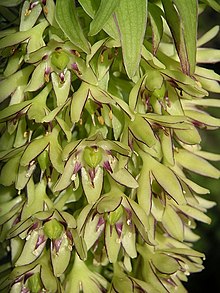| Eucomis bicolor | |
|---|---|

| |
| Scientific classification | |
| Kingdom: | Plantae |
| Clade: | Tracheophytes |
| Clade: | Angiosperms |
| Clade: | Monocots |
| Order: | Asparagales |
| Family: | Asparagaceae |
| Subfamily: | Scilloideae |
| Genus: | Eucomis |
| Species: | E. bicolor |
| Binomial name | |
| Eucomis bicolor Baker | |
Eucomis bicolor, the variegated pineapple lily or just pineapple lily, is a bulbous species of flowering plant in the family Asparagaceae, subfamily Scilloideae, native to Southern Africa (the Cape Provinces, Lesotho, KwaZulu-Natal, the Free State, and the Northern Provinces). The pale green, purple-margined flowers are arranged in a spike (raceme), topped by a "head" of green leaflike bracts. It is cultivated as an ornamental bulbous plant, although its flowers have an unpleasant smell, attractive to the main pollinators, flies.
Description

Eucomis bicolor is a perennial growing from a large bulb. It reaches 30–60 cm (12–24 in) in height, with a basal rosette of wavy leaves 30–50 cm (12–20 in) long. In late summer (August in the UK), it produces a stout stem (peduncule), often with purple markings. The inflorescence is a raceme of pale green, purple margined flowers with tepals up to 15 mm (1⁄2 in) long, borne on pedicels 2 cm (3⁄4 in) long. The inflorescence is terminated by a head (coma) of pale green leafy bracts, sometimes tinged with purple. At close quarters the flowers have a strongly unpleasant smell. The ovary is green.
The homoisoflavanones eucomin, eucomol, (E)-7-O-methyl-eucomin, (—)-7-O-methyleucomol, (+)-3,9-dihydro-eucomin and 7-O-methyl-3,9-dihydro-eucomin can be isolated from bulbs of E. bicolor.

Taxonomy
Eucomis bicolor was first described by John Gilbert Baker in 1878. The specific epithet bicolor means "two-coloured"; the tepals are pale green with purple margins. It is one of a group of larger tetraploid species of Eucomis, with 2n = 4x = 60.
Distribution and habitat
Eucomis bicolor is native to Southern Africa (the Cape Provinces, Lesotho, KwaZulu-Natal, the Free State, and the Northern Provinces). Along the Drakensberg escarpment it is found in damp grassland, often near streams, up to elevations of 2,500 m (8,200 ft).
Ecology

Eucomis bicolor is primarily pollinated by flies, including blowflies, house flies and flesh flies, attracted by the sulphur compounds in the scent of the flowers.
Cultivation
In cultivation, Eucomis bicolor is not fully frost-hardy. In the US, it is classed as hardy in USDA zones 8–10, and requires a winter mulch in colder areas (zones 6–7). In the UK, it is said to be hardy down to −10 °C (14 °F), if kept dry in winter. Sun exposure and plentiful water are required in summer for successful flowering. It has gained the Royal Horticultural Society's Award of Garden Merit.
The cultivar E. bicolor 'Alba' has plain white flowers and lacks any purple coloration. It resembles Eucomis autumnalis but can be distinguished by the long flower stalks (pedicels).
References
- ^ "Eucomis bicolor". World Checklist of Selected Plant Families. Royal Botanic Gardens, Kew. Retrieved 11 August 2015.
- ^ "Pineapple lily – Eucomis bicolor". Fine Gardening. Retrieved 15 October 2018.
- ^ Compton, James (1990). "Eucomis L'Heritier". The Plantsman. 12 (3): 129–139.
- "August 2011 Plant Profile: Eucomis bicolor". University of Washington Botanic Gardens. Retrieved 26 July 2013.
- RHS A-Z encyclopedia of garden plants. United Kingdom: Dorling Kindersley. 2008. p. 1136. ISBN 978-1405332965.
- Heller, W. & Tamm, Ch. (1981). "Homoisoflavanones and Biogenetically Related Compounds". Fortschritte der Chemie organischer Naturstoffe / Progress in the Chemistry of Organic Natural Products, Volume 40. pp. 105–152. doi:10.1007/978-3-7091-8611-4_3.
- Heller, W.; Andermatt, P.; Schaad, W.A. & Tamm, C. (1976). "Homoisoflavonones. IV. New constituents of the eucomin series of Eucomis bicolor". Helvetica Chimica Acta. 59 (6): 2048–2058. doi:10.1002/hlca.19760590618. PMID 1017955.
- Harrison, Lorraine (2012). RHS Latin for gardeners. United Kingdom: Mitchell Beazley. p. 224. ISBN 9781845337315.
- Zonneveld, B.J.M. & Duncan, G.D. (2010). "Genome sizes of Eucomis L'Hér. (Hyacinthaceae) and a description of the new species Eucomis grimshawii G.D.Duncan & Zonneveld". Plant Systematics and Evolution. 284 (1–2): 99–109. doi:10.1007/s00606-009-0236-y.
- "Eucomis bicolor Baker". Plants of the World Online. Royal Botanic Gardens, Kew. Retrieved 15 October 2018.
- "Eucomis bicolor AGM". Royal Horticultural Society. Retrieved 19 June 2020.
External links
- Dibakwane, Dineo (July 2015). "Eucomis bicolor". PlantZAfrica.com. SANBI. Retrieved 7 November 2018.
| Taxon identifiers | |
|---|---|
| Eucomis bicolor |
|